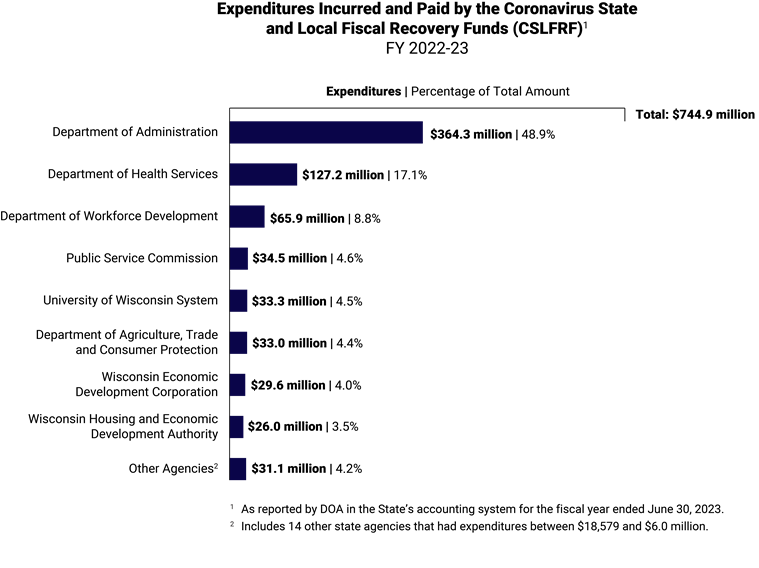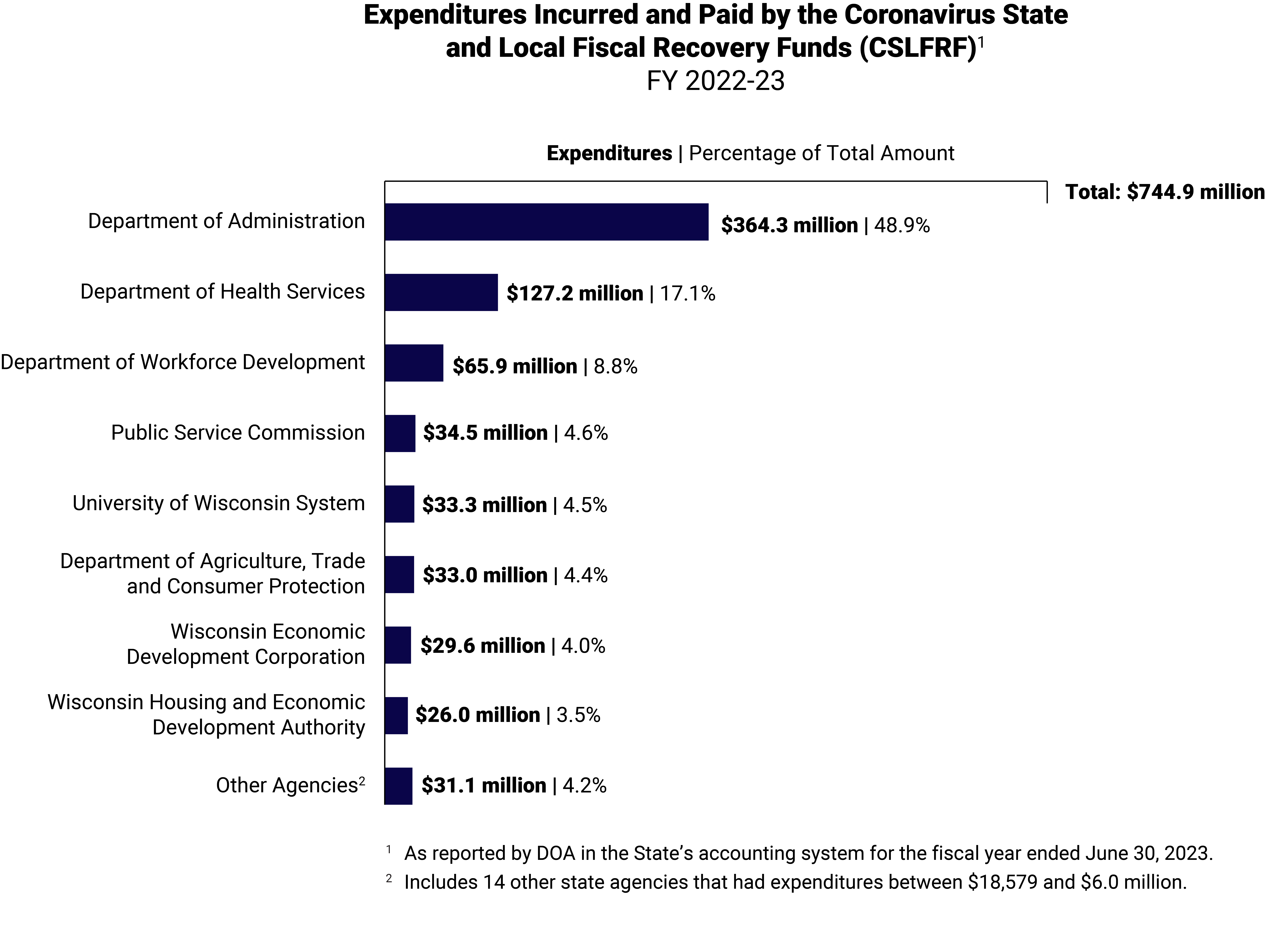The Department of Administration (DOA) prepares the Annual Comprehensive Financial Report (ACFR), which contains the financial statements of the State of Wisconsin prepared in accordance with generally accepted accounting principles (GAAP) prescribed by the Governmental Accounting Standards Board (GASB). The ACFR includes financial information on state funds, including the State’s General Fund, the Transportation Fund, the University of Wisconsin (UW) System, the Unemployment Reserve Fund, and the Wisconsin Retirement System.
We provided unmodified opinions on the financial statements and related notes of the State of Wisconsin as of and for the year ended June 30, 2023. We provide an unmodified opinion when audit evidence supports the conclusion that the financial statements provide a fair view of an entity’s financial activity in accordance with GAAP. Our unmodified opinions are included in the State’s ACFR, which may be found on DOA’s website. We conducted the financial audit by auditing the State’s financial statements in accordance with applicable government auditing standards, issuing our auditor’s opinions, reviewing internal controls, and issuing our auditor’s report on internal control and compliance.
We also reviewed certain aspects of the federal funding the State received for the public health emergency, and we include in our report certain other matters of interest related to the State’s fiscal year (FY) 2022-23 activities.
Total revenue decreased by $840.2 million and was $38.6 billion in FY 2022-23. This decrease was largely attributed to a decrease of $1.2 billion in income tax revenues and a decrease of $302.6 million in federal revenue the State received primarily as a result of the public health emergency. Total expenditures increased by $801.5 million and were $34.4 billion in FY 2022-23. This increase was largely the result of grants and aid to individuals and organizations related, in part, to the public health emergency, increases in Medical Assistance (MA) Program expenditures, and increases in aids to schools.
The fund balance of the General Fund is made up of several components, and the largest is the unassigned fund balance. The unassigned fund balance, which are amounts that are not restricted or committed for a specific purpose, totaled $3.8 billion. The unassigned fund balance represents that, as of June 30, 2023, more resources were available than were spent or obligated in the short term.
The committed fund balance of $1.8 billion is made up of the amounts held in the statutory Budget Stabilization Fund, also known as the State’s rainy day fund. The balance in this fund increased by $66.3 million in FY 2022-23, primarily from interest income.
The State repaid long-term debt in excess of new debt issuances during FY 2022-23, resulting in a decrease in overall debt. The $1.4 billion in new general obligation bonds and notes issued during FY 2022-23 included $645.3 million for UW System academic facilities and $222.9 million for transportation projects.
In FY 2022-23, DOA transferred $39.7 million in expenditures for the Wisconsin Tomorrow Small Business program to be paid by the Coronavirus Relief Fund (CRF). The CRF program ended in FY 2022-23.
Separate from the CRF, the Coronavirus State and Local Fiscal Recovery Funds (CSLFRF) distributed money directly to state, local, tribal, and territorial governments. The State was allocated $3.0 billion in funding and was advanced $1.5 billion in May 2021, $1.3 billion in May 2022, and $205.8 million in June 2022. Federal regulations stipulate that eligible expenditures must be incurred between March 3, 2021, and December 31, 2024, and spent through December 31, 2026. DOA reported that $744.9 million in expenditures at 22 state entities was incurred and paid by the CSLFRF in FY 2022-23. The largest total expenditures were incurred by DOA, the Department of Health Services (DHS), and the Department of Workforce Development (DWD).


Wisconsin’s federal medical assistance percentage (FMAP) is the percentage of medical assistance expenditures the federal government will fund for the State. The FMAP increased by 6.2 percent in March 2020, and will be phased out through December 2023. For the period April 1, 2023 through June 30, 2023, the temporary increase to Wisconsin’s FMAP was 5.0 percent. DHS reported the State received $665.8 million in additional funding in FY 2022-23 as a result of the increased FMAP. In addition, DHS also claimed and received an additional $75.5 million in federal funds in FY 2022-23 under the MA Program, as allowed under the American Rescue Plan Act (ARPA).
We reported three significant deficiencies related to information technology (IT) security at DOA. We note that DOA continued to be in statutory noncompliance by providing insufficient oversight and monitoring of executive branch agency IT operations. Given that these concerns have continued for several years, we recommend that DOA report to the Joint Legislative Audit Committee by March 1, 2024, on the status of its efforts to take corrective actions and implement our recommendations.
In addition, we make a recommendation to DHS to improve its financial reporting for opioid settlement funds.
We also communicated with the responsible state agencies on the following other matters of interest:
- the recording by DOA of $68.3 million in interest earnings on advanced funding for the CSLFRF grant program;
- the recovery by DHS of $43.0 million in MA funding resulting from a recommendation in report 23-4;
- a deficit balance of $45.7 million as of June 30, 2023, in the Unemployment interest and penalty account in the General Fund, which DWD indicates will take 16 years to resolve;
- a continuing balance of $21.2 million as of June 30, 2023, in the health insurance fringe benefit variance account, which DOA is responsible for resolving; and
- the reconciliation and certification of appropriation balances to DOA for three appropriations as required under s. 16.52 (5) (b), Wis. Stats.




